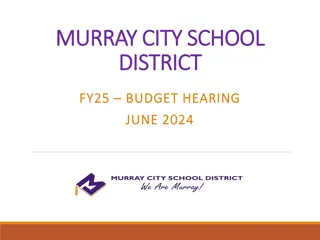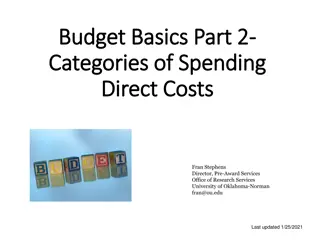Understanding Title I, Part A CIP Budget Narrative Requirements
This walkthrough explains the purpose of Title I, Part A funds, focusing on providing equitable education opportunities and addressing achievement gaps for students in need. It covers important aspects such as the Supplement Not Supplant rule, federal funds timeline, and consultation for equitable services.
Download Presentation

Please find below an Image/Link to download the presentation.
The content on the website is provided AS IS for your information and personal use only. It may not be sold, licensed, or shared on other websites without obtaining consent from the author. Download presentation by click this link. If you encounter any issues during the download, it is possible that the publisher has removed the file from their server.
E N D
Presentation Transcript
Title I, Part A CIP Budget Narrative Walkthrough
Outcomes for today Overview of Title I, Part A Walkthrough of CIP Budget Narrative components Resources & Contacts Oregon Department of Education 2
The purpose of Title I, Part A is a to provide all children significant opportunity to receive a fair, equitable, and high-quality education, and to close educational achievement gaps. Purpose of Title I-A The goal is to address opportunity gaps that some students experience by providing resources to districts and schools who serve a larger population of children from families experiencing poverty. 3 Oregon Department of Education
Supplement Not Supplant Federal funds cannot be used to supplant, or take the place of, state and local funds that would have been spent if Title I-A funds were not available There are three fiscal tests for Title I-A through which districts demonstrate that the use of Title I-A funds is supplemental Supplement not Supplant Title IA Fiscal Requirements ESSA Quick Reference Brief: Methodology ESSA Quick Reference Brief: Comparability ESSA Quick Reference Brief: Supplement not Supplant Oregon Department of Education Maintenance of Effort Comparability 4
JULY 2024 AUG 2024 NOV 2024 2024-25 FEDERAL FUNDS TIMELINE 2024-25 BUDGET NARRATIVES DUE 2024-25 BUDGET NARRATIVE APPLICATION OPENS BEGINNING OF 2024-25 GRANT PERIOD NOV 2025 SEPT 2025 FINAL DATE FOR ALL 2024-25 CLAIMS FOR *INITIAL GRANT PERIOD FINAL DATE FOR OBLIGATION OF 2024-25 FUNDS FOR *INTIAL GRANT PERIOD NOV 2025 UNCLAIMED FUNDS BECOME CARRYOVER NOV 2025 NOV 2026 SEPT 2026 *INITIAL GRANT PERIOD: 7/1/24 9/30/25 (15 MONTHS) CARRYOVER APPLICATIONS FOR 2024-25 FUNDS OPEN FINAL DATE FOR OBLIGATION OF 2024- 25 FUNDS FINAL DATE FOR ALL 2024-25 GRANT CLAIMS Oregon Department of Education 5
Timely, meaningful, annual consultation Equitable Services Equitable share is generated by children experiencing poverty who by age and address would have attended a public Title I-A school (poverty and residence) Services are provided to eligible students identified as having the greatest need (need and residence) ESSA Quick Reference Brief: Equitable Services Oregon Department of Education 6
Application Requirements Title I-A CIP Budget Narrative Oregon Department of Education 7
Accessing the CIP Budget Narrative Login to the District Secure website Choose CIP Budget Narrative from the Applications list If you do not have access to the CIP Budget Narratives, reach out to your district Security Administrator Oregon Department of Education 8
Title I-A Application Requirements Overview Targeting Page How do we rank and serve schools? Set-Asides What funds are being spent at the district level? Budget Narrative How are schools using their funds in alignment with their plans? What is our methodology? Oregon Department of Education 9
Overview (Methodology) Description of how the district allocates state and local funds to all schools Single school districts, or districts with one school per grade span, do not need to provide a methodology statement and can enter NA Methodology statement considerations: Public charter schools Different grade spans ESSA Quick Reference Brief: Methodology Oregon Department of Education 10
Targeting Page Identify which schools are receiving Title I-A funds Determine per child amount for each school Ensure that rank and serve requirements outlined in ESSA are followed *PLEASE NOTE: The allocation for each school on the Targeting Page must equal each school s allocation on the Budget Narrative Page ESSA Quick Reference Brief: Rank and Serve under Title I-A Oregon Department of Education 11
Targeting Page A Closer Look Oregon Department of Education 12
Selecting Measures of Poverty 1.Free and reduced-price lunch count or Community Eligibility Provision (CEP) data 2.Count of students receiving assistance under Temporary Assistance for Needy Families (TANF) 3.Count of student eligible for Medicaid (Oregon Health Plan) 4.Census counts of children from families below the poverty level (SAIPE) 5.A combination of two or more of these data sources Oregon Department of Education 13
Community Eligibility Provision The Community Eligibility Provision (CEP) gives eligible Local Education Agencies (LEAs) and schools with high percentages of low-income children the option to offer meals without cost to all children in those schools without collecting free and reduced lunch applications. CEP is coordinated through the ODE s Office of Child Nutrition. Oregon Department of Education 14
When all schools in the district are CEP Option 1: Use the number of identified eligible students in each school Option 2: Use the number of identified eligible students in each school times the multiplier (1.6) Oregon Department of Education 15
When only some schools in the district are CEP Option 1: Use the number of eligible students in both CEP and non-CEP schools CEP Schools Option 2: Apply the 1.6 multiplier to the number of identified eligible students in both CEP and non-CEP schools Option 3: Use the number of identified eligible students times the multiplier (1.6) and use the free and reduced-price meal data for non-CEP schools Non-CEP Schools Oregon Department of Education 16
Required Set-Asides Required for ALL districts Services for students experiencing houselessness, regardless of whether they attend a Title I-A funded school Required for SOME districts Parent and family engagement Equitable services for private school students Services for students without parental supervision* *Only 2 districts in Oregon are required to use this set-aside Oregon Department of Education 17
Required Set-Aside (Houselessness) Services for students experiencing houselessness Support eligible students in ALL schools, not just Title I-A funded schools Consider the number of students identified experiencing houselessness when calculating set-aside Primary goal of the set-aside is to remove barriers to student engagement and participation in education (e.g.; transportation for school of origin, fees for extracurricular activities/athletics, extended day programs) Oregon Department of Education 18
Required Set-Asides (for some districts) Equitable Services for private school students Equitable services are based on the proportionate share of the district s total Title I-A allocation Calculated before any other set-asides are taken Calculation of Equitable Share = % of private school students experiencing poverty from Targeting Page X total allocation Per Pupil Allocation (PPA) = Equitable share / # of private school students experiencing poverty Oregon Department of Education 19
Required Set-Asides (for some districts), Part II Parent and family engagement Only required for districts with allocations of $500K+ Required to set-aside 1% of the total district allocation; 90% of the 1% must go to Title I-A schools Districts with participating private schools must reserve 1% of the proportional share allocated for equitable services Oregon Department of Education 20
Optional Set-Asides District Administration Costs to administer in district and equitable services to private schools Salary Equalization Establishes equity in funding between Title I-A funded schools Extended Time Before/after/summer school Oregon Department of Education 21
Optional Set-Asides, Part II Professional Development Title I-A schools ONLY Additional Set-Asides Early Learning activities in Title I-A schools Supports for students experiencing Foster Care Supplement services to students in locally run facilities or community day programs ESSA Quick Reference Brief: Set-Asides under Title I-A Oregon Department of Education 22
Budget Narrative Create a line item for each funded school Describe how funds are being spent in alignment with identified needs and school plan Amounts listed for each school on budget narrative page must match the amount listed for that school on Targeting Page Oregon Department of Education 23
Title I-A web page Resources Title I-A Coordinator s Calendar ESSA Quick Reference Briefs Oregon Federal Funds Guide Within District Allocations under I-A CEP and Requirements under I-A CIP Budget Narrative Resources Oregon Department of Education 24
Jen Engberg Clackamas, Columbia Gorge, Multnomah and Northwest Regional Sarah Martin Douglas, Lake, Malheur, South Coast and Southern Oregon Lisa Plumb Lane, Linn Benton Lincoln and Willamette Regional Contacts by ESD Amy Tidwell o Grant, Harney, High Desert, InterMountain, Jefferson, North Central and Region 18 Oregon Department of Education 25
Please reach out! Lexi Neeman - McKinney-Vento Program Lexi.Neeman@ode.oregon.gov Jen Engberg Jennifer.Engberg@ode.oregon.gov Sarah Martin Sarah.Martin@ode.oregon.gov Janette Newton - Private Schools Janette.Newton@ode.oregon.gov Marlie Magill - Foster Care Marlie.Magill@ode.oregon.gov Jon Mabale - CEP Jon.Mabale@ode.oregon.gov Lisa Plumb Lisa.Plumb@ode.oregon.gov Amy Tidwell Amy.Tidwell@ode.oregon.gov Oregon Department of Education 26























